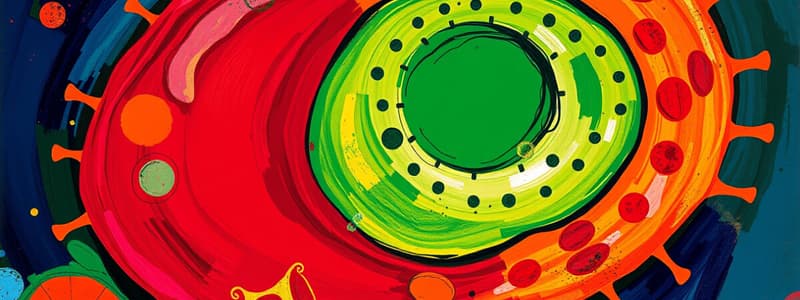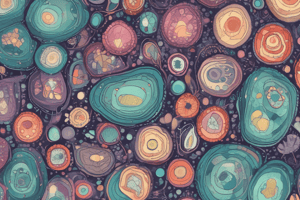Podcast
Questions and Answers
What is the function of the Cell Membrane?
What is the function of the Cell Membrane?
- Provides energy
- Structure and support for the cell (correct)
- Stores waste
- Transport materials
What does Cytoplasm do?
What does Cytoplasm do?
- Surrounds all parts of the cell (correct)
- Stores food
- Produces energy
- Carries information
What is the role of the Endoplasmic Reticulum?
What is the role of the Endoplasmic Reticulum?
- Transport materials (correct)
- Control cell processes
- Store waste
- Generate energy
What is the function of the Golgi Apparatus?
What is the function of the Golgi Apparatus?
What is the primary function of the Mitochondrion?
What is the primary function of the Mitochondrion?
What does the Nucleus do?
What does the Nucleus do?
What is the function of a Vacuole?
What is the function of a Vacuole?
What is a Cell Wall?
What is a Cell Wall?
What is the function of Mitochondria?
What is the function of Mitochondria?
What is the Cell?
What is the Cell?
Define organelles.
Define organelles.
What distinguishes a plant cell?
What distinguishes a plant cell?
What defines an animal cell?
What defines an animal cell?
What is the Cytoplasm?
What is the Cytoplasm?
What is the Nucleus known as?
What is the Nucleus known as?
What is the role of the Chloroplast?
What is the role of the Chloroplast?
What is a Vacuole?
What is a Vacuole?
What are Lysosomes?
What are Lysosomes?
What is the function of the Nucleolus?
What is the function of the Nucleolus?
What is the Nuclear Membrane?
What is the Nuclear Membrane?
What are Ribosomes?
What are Ribosomes?
Study Notes
Animal and Plant Cell Structure
- Cell Membrane: Provides structure and support; regulates what enters and exits the cell.
- Cytoplasm: Gel-like substance filling the cell, supporting organelles and facilitating chemical reactions.
- Endoplasmic Reticulum: Essential for the transport of materials; can be rough (with ribosomes) or smooth (without ribosomes).
- Golgi Apparatus: Modifies, sorts, and packages proteins and lipids for transport.
- Mitochondrion: Known as the "Power House" of the cell; responsible for cellular respiration and energy production.
- Nucleus: Acts as the control center; stores DNA and regulates cellular activities, including reproduction.
- Vacuole: Functions as a storage unit for food, water, waste, and other substances within the cell.
- Cell Wall: Rigid outer layer found in plant cells; provides additional support and protection.
Differences Between Cell Types
- Plant Cell: Contains a cell wall, chloroplasts for photosynthesis, and a large central vacuole.
- Animal Cell: Lacks a cell wall and chloroplasts, features a smaller vacuole.
Unique Organelles and Structures
- Chloroplast: Site of photosynthesis in plant cells, converting light energy to chemical energy.
- Lysosomes: Contain enzymes for digesting cellular waste and foreign materials.
- Nucleolus: Dense structure within the nucleus responsible for ribosomal RNA synthesis.
- Nuclear Membrane: Double-layered membrane enclosing the nucleus, continuous with the endoplasmic reticulum.
Additional Cell Components
- Ribosomes: Small particles composed of RNA and proteins; essential for protein synthesis by translating messenger RNA.
- Organelles: Specialized structures within cells, each performing specific functions vital for cell survival and efficiency.
Summary of Cell Fundamentals
- Cell: The basic unit of life; all living organisms are made of cells.
- Mitochondria and Chloroplasts are crucial for energy production in their respective cell types.
- Vacuoles serve as storage compartments, playing vital roles in maintaining cell homeostasis.
Studying That Suits You
Use AI to generate personalized quizzes and flashcards to suit your learning preferences.
Description
Test your knowledge on the parts of animal and plant cells with this 7th-grade science quiz. Identify key components like the cell membrane, cytoplasm, and organelles such as the endoplasmic reticulum and Golgi apparatus. Perfect for reinforcing cell structure concepts in a fun way!




